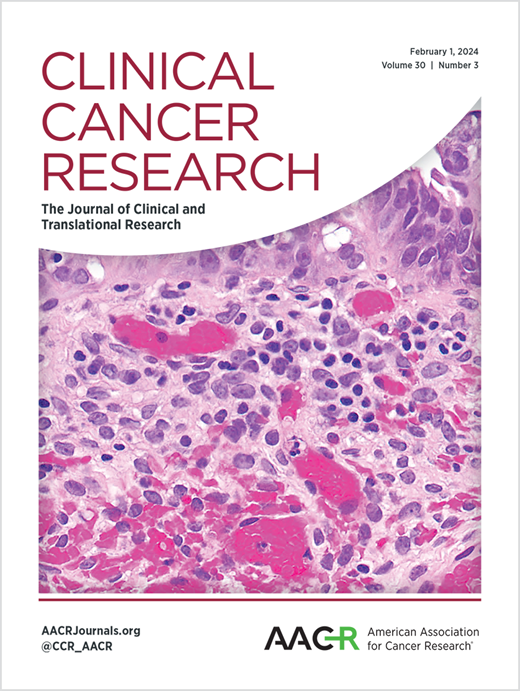早期三阴性乳腺癌新辅助化疗-免疫治疗后复发的时机。
IF 10.2
1区 医学
Q1 ONCOLOGY
引用次数: 0
摘要
新辅助化疗免疫治疗高风险三阴性乳腺癌(TNBC)已被证明可以降低复发风险并提高生存率。然而,转移性TNBC患者的预后仍然很差,特别是那些早期复发的患者,他们的需求迫切未得到满足。确定化疗免疫治疗后最常见的复发时间对于塑造未来临床试验的设计至关重要。方法:我们分析了5项早期TNBC新辅助化疗-免疫治疗的临床试验,以量化早期复发(随机化后24个月内)对总复发风险的贡献。使用PlotDigitizer从Kaplan-Meier曲线中提取无事件生存数据。事件的评估持续了48个月,在这个时间框架内,各试验的随访一致,后期事件最少。主要终点是48个月早期复发与总复发的比例;二级分析按病理完全缓解状态分层。结果免疫治疗组48个月的总复发率分别为:14.3% (GeparNuevo)、14.8% (NSABP-B59/GeparDouze)、17.5% (KEYNOTE-522)、20.2% (IMpassion031)和29.2% (NeoTRIP)。早期复发率从NSABP-B59/GeparDouze组的64.6%到GeparNuevo组的82.9%不等。在新辅助治疗后残留病变患者中,这一比例更高(范围为69.4%至88.6%)。达到病理完全缓解的患者早期和晚期事件的比例相似。结论在新辅助化疗-免疫治疗后复发的TNBC患者中,24个月内复发占大多数。需要临床试验来确定这一患者群体的最佳治疗方法。本文章由计算机程序翻译,如有差异,请以英文原文为准。
Timing of Recurrence After Neoadjuvant Chemo-Immunotherapy in Early-Stage Triple-Negative Breast Cancer.
INTRODUCTION
Neoadjuvant chemo-immunotherapy for high-risk triple-negative breast cancer (TNBC) has been shown to reduce the risk of recurrence and improve survival. However, the prognosis for patients with metastatic TNBC remains poor, especially for those with an early recurrence, who represent an urgent unmet need. Defining the most common timing of recurrences after chemo-immunotherapy is crucial for shaping the design of future clinical trials.
METHODS
We analyzed five clinical trials of neoadjuvant chemo-immunotherapy in early-stage TNBC to quantify the contribution of early recurrences (within 24 months from randomization) to the overall risk of relapse. Event-free survival data were extracted from Kaplan-Meier curves using PlotDigitizer. Events were evaluated up to 48 months, a time frame with consistent follow-up across trials and minimal later events. The primary endpoint was the proportion of early versus total recurrences by 48 months; secondary analyses stratified this by pathological complete response status.
RESULTS
Overall recurrence rates by 48 months in the immunotherapy arms were: 14.3% (GeparNuevo), 14.8% (NSABP-B59/GeparDouze), 17.5% (KEYNOTE-522), 20.2% (IMpassion031), and 29.2% (NeoTRIP). The proportion of early relapse ranged from 64.6% in NSABP-B59/GeparDouze to 82.9% in GeparNuevo. This proportion was higher in patients with residual disease after neoadjuvant therapy (range 69.4% to 88.6%). Patients who achieved a pathological complete response showed a similar proportion of early and late events.
CONCLUSIONS
Recurrences within 24 months account for majority of recurrences in TNBC patients who relapse after neoadjuvant chemo-immunotherapy. Clinical trials are needed to define the optimal therapy for this patient population.
求助全文
通过发布文献求助,成功后即可免费获取论文全文。
去求助
来源期刊

Clinical Cancer Research
医学-肿瘤学
CiteScore
20.10
自引率
1.70%
发文量
1207
审稿时长
2.1 months
期刊介绍:
Clinical Cancer Research is a journal focusing on groundbreaking research in cancer, specifically in the areas where the laboratory and the clinic intersect. Our primary interest lies in clinical trials that investigate novel treatments, accompanied by research on pharmacology, molecular alterations, and biomarkers that can predict response or resistance to these treatments. Furthermore, we prioritize laboratory and animal studies that explore new drugs and targeted agents with the potential to advance to clinical trials. We also encourage research on targetable mechanisms of cancer development, progression, and metastasis.
 求助内容:
求助内容: 应助结果提醒方式:
应助结果提醒方式:


